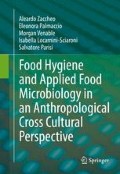Abstract
The human microbiomes can be seen as “the entire collection of genes found in all of the microbes associated with a particular host” and the entire “collection of microbes that live in the human habitat”. These microbial associations have specific locations and functions. Skin diseases are frequently associated with a destabilization of skin microbes. In oral health, the current and frequent approach “to maintain oral health relies on the concept of stabilizing oral microbiota” in a compatible state with health. Intestines and colon contain the “densest known microbial communities on Earth”, and changes in its composition have associated to disease such as “irritable bowel syndrome, inflammatory bowel disease, allergic diseases” and “autoimmune disorders, diabetes, obesity and gastrointestinal cancer”.
Access this chapter
Tax calculation will be finalised at checkout
Purchases are for personal use only
References
Beck R (2000) Chronology of microbiology in historical context. In: A chronology of microbiology in historical context. ASM Press, Washington, DC, pp 1–335. doi:10.1128/9781555818081.ch1
Mahar MI, Reid A (2011) FAQ: E. Coli: good, bad, and deadly. http://academy.asm.org/images/stories/documents/EColi.pdf. Accessed 27 July 2014
Reid A, Greene S (2014) FAQ: human microbiome. http://academy.asm.org/images/stories/documents/FAQ_Human_Microbiome.pdf. Accessed 29 Jan 2014
Reid A, Greene S (2014) FAQ: human microbiome, trifold. http://academy.asm.org/images/stories/documents/ColloquiaDoc/ASM%20Trifold.pdf. Accessed 29 Jan 2014
Reid A, Greene S (2014) FAQ: human microbiome, infographic. http://academy.asm.org/images/stories/documents/ColloquiaDoc/Microbiome%20Infographic.pdf. Accessed 29 Jan 2014
Lamont RJ, Hajishengallis GN, Jenkinson HF (2014) Oral microbiology and immunology. In: Jenkinson HF (ed) General microbiology, 2nd edn. American Society of Microbiology, Washington, DC, pp 20–23, Chapter 1
Lamont RJ, Hajishengallis GN, Jenkinson HF (2014) Oral microbiology and immunology. In: Scannapieco FA (ed) The oral environment, 2nd edn. American Society of Microbiology, Washington, DC, pp 51–76, Chapter 3
Paliy O, Kenche H, Abernathy F, Michail S (2009) High-throughput quantitative analysis of the human intestinal microbiota with a phylogenetic microarray. Appl Environ Microbiol 75(11):3572–3579
Author information
Authors and Affiliations
Rights and permissions
Copyright information
© 2017 Springer International Publishing Switzerland
About this chapter
Cite this chapter
Zaccheo, A., Palmaccio, E., Venable, M., Locarnini-Sciaroni, I., Parisi, S. (2017). The Human Microbiomes. In: Food Hygiene and Applied Food Microbiology in an Anthropological Cross Cultural Perspective. Springer, Cham. https://doi.org/10.1007/978-3-319-44975-3_8
Download citation
DOI: https://doi.org/10.1007/978-3-319-44975-3_8
Published:
Publisher Name: Springer, Cham
Print ISBN: 978-3-319-44973-9
Online ISBN: 978-3-319-44975-3
eBook Packages: Chemistry and Materials ScienceChemistry and Material Science (R0)

